
Bridgepoint Music's Yelp profile
APRIL 22 | A MUSIC INC. EXCLUSIVE I BY KATHLEEN COSTANZA
To Yelp, Or Not To Yelp?
When it comes to negative reviews, that’s the question for retailers.
Few things are inevitable in life. Death, taxes and — for small businesses — a Yelp profile.
Unlike a website or social media account, business owners don’t create a Yelp page, and they have limited control over the content. Still, on Google searches, Yelp profiles often hover right under the websites and social media accounts retailers work so hard to maintain — making Yelp a reality for a retailer’s online presence, whether they want it to be or not.
By the end of 2013, there were about 53 million reviews on Yelp — 23 percent of which are in shopping categories. So the inevitability of a Yelp profile springing up begs the question, should retailers respond to negative Yelp reviews? What about positive ones? Experts say by following a few guidelines, Yelp has potential to be harnessed as another tool to reach customers where they’re spending time.
Yelp 101
Before responding to reviews, there’s a critical first step: claiming your business. After a Yelp business owner’s account is created, owners can go in and update information, add photos, and write a few paragraphs about the business.
“You wouldn't have a brick-and-mortar store without signage,” said Liz Jostes, co-founder of Eli | Rose Social Media, a social media and marketing consultancy for small businesses. Jostes said keeping your information up to date across every online platform, not just Yelp, has become a priority for customers searching for local businesses. “You wouldn't not mow your grass or clean your store windows. People have basic expectations of your online presence like they'd have of your brick and mortar store.”
She added to make sure the business has been categorized correctly. If your store primarily does retail, make sure it’s not under “musical instrument repair.”
Negative Reviews
Claiming a business and updating information is straightforward. Responding to reviews is where things get tricky.
Joe Chapman, Web assistant at bow and string instrument supplier SHAR, responds to each review left on the Yelp profile for the company’s retail showroom in Ann Arbor, Mich.
“If a customer walks into our showroom, an employee should go up and talk with them,” Chapman said. “I don't see it any differently than that.”
Rachel Krueger, director of e-commerce at SHAR, added the way the company approaches Yelp stems from the company’s overall philosophy. She and Chapman said the company takes action on the reviews and investigates how they can improve.
“We're always welcoming positive and negative feedback and it's important to us to be proactive in fixing any problems that the customer may have,” she said. “We wouldn't want to neglect any channel because we feel like all these different channels are basically feelers into the population.”
James Manganaro, owner of Bridgepoint Music in Menlo Park, Calif., said his plan for negative reviews is to “answer any questions, explain something that might have gone wrong, apologize for something that might have been done incorrectly and then offer to fix the problem.”
But there’s a greater impetus for responding than reconnecting with one customer.
“I care if a customer had a bad experience and I want to make it right. But I also care that everybody else can see that's how customers who have a bad experience are treated,” Manganaro said.
However, Manganaro cautions that responding to a negative review might legitimize it and pull it out of the review filter and onto the landing page. It’s hard to tell though, as Yelp keeps its algorithm for what stays hidden and what appears on the front page a secret. That secrecy, which frustrates Manganaro and so many other business owners, has received national attention for years. Last month, The Wall Street Journal reported over 2,000 complaints had been filed with the FTC since 2008 against Yelp, many from business owners who say their positive reviews get filtered while negative reviews stay up if they refuse to advertise. Throughout numerous lawsuits, Yelp has repeatedly denied that advertising dollars affect the content on pages.
The Other Side of Yelp
According to the site, most of Yelp isn’t negative reviews, though. Yelp says 67 percent of all reviews are either 4 or 5 stars.
While every situation is different, Jostes said she would err on the side of not responding to positive reviews at risk it might trigger sucking the review into the filter.
However, Chapman and Manganaro both respond to positive reviews and add more information. For example, a recent review on Bridgeport Music’s page praised how the store had baritone saxes available to rent. Manganaro added they also have other tougher-to-find instruments like bassoons and tubas.
Like other retailers across the country, Manganaro has had a rocky relationship with the site and said he understands the hesitancy of retailers to become active on Yelp. He says not becoming active, though, might be a missed chance to connect with customers.
“I do think it's a missed opportunity,” he said. “But I can understand the fear and the tentativeness. You are taking a risk when you [become active] on Yelp and encourage people to use it. People are going to do what they're going to do. But to me, you take a risk when you open your doors for business.” MI
| 



